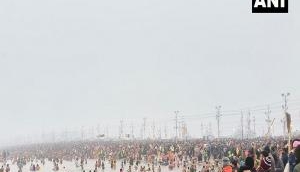Modern slave trade: how to count a 'hidden' population of 46 million

In 1860, just before the outbreak of the American Civil War, the United States carried out a national census. One result was the very precise count of 3,953,761 slaves in the country, amounting to 12.6% of the total population. It was the last clear cut count of slavery in a national population in history.
Since the abolition of legal slavery, it has become a hidden and uncountable crime, making it hard to gauge the number of people truly affected. Globally, slavery takes many forms, with most slaves doing dirty, dangerous, demeaning work - digging and breaking rocks, shaping bricks by hand, cutting down forests with hand axes, or scrubbing floors.
Modern slavery is especially hard to measure compared to other crimes. This is something Walk Free and Hull University's Wilberforce Institute has tried to change with the Global Slavery Index. By applying a method which was first used to estimate the number of fish in a Swedish fjord, and combining it with a survey of more than 25 countries, researchers have been able to get a widespread picture on the crime of slavery, from a global perspective.
The 2016 Global Slavery Index estimates there are 45.8m people worldwide in slavery today. This is an increase on previous estimates of 36m, but this does not necessarily mean that slavery is on the rise. Instead, the best way to view this figure is simply that the microscope is getting stronger, and better focused every year. This means we are now able to see slavery much more clearly, in places we weren't able to in the past.
Counting a crime
In criminology, the difference between the actual number of crimes and the officially reported number of crimes is called the "dark figure". There is a "rule of dark figures" which states that the more serious the crime, the more likely it is to be reported to the authorities. For example, the dark figure for murder is normally far below 1%, but the dark figure for vandalism might be as high as 95% - so nearly everyone who experiences vandalism doesn't bother to report it. This is a clear pattern in most countries, but there are two types of crime that often confound this rule.
Rape and sexual assault are very serious crimes, but are rarely reported to the police. This is primarily due to the social stigma attached to and felt by those who have been assaulted, along with the fear they might not be believed. Victims of slavery also feel stigma and shame, in part because sexual assault is very common in slavery cases. But slavery also defies measurement for a unique reason.
Normally, to determine the level of any specific crime in developed countries, the results of a national sample crime survey are compared to the official arrest and conviction rate. When being counted, all crimes are treated as "events" - also known as short single episodes - a mugging for example may only take one or two minutes.
But slavery is a crime which starts, and then continues for an indeterminate time - the victimisation may last for days, months, or even years. This unique fact about slavery crime means it can rarely be measured using national crime surveys, as the victim is so often hidden away, enslaved, and not available to answer questions.
Understanding slavery
This is what researchers are up against when they try to understand the scale of slavery across the world. In an attempt to combat this, for the slavery index, we cast the net wider and instead of just individuals, we surveyed households and families to see if anyone knew anyone who had experience of slavery.
Much like the 1860 US Census, these surveys provide an estimate of the proportion of the population who are enslaved, and includes cases that happened in other countries. For example, respondents in national surveys in Nepal identified significant numbers of family members enslaved in Qatar and other Gulf States.
These household surveys work well in countries in the developing world, but in North America and Europe more active law enforcement means criminals work hard to keep their slaves hidden - plus the total number of slaves in the population is much smaller. Fortunately a statistical technique called multiple systems estimation (MSE) can provide reliable estimates of these hidden populations.
First used to estimate the number of fish in a Swedish fjord, MSE has been regularly used to determine the number of civilian deaths in ongoing conflicts, such as the current civil war in Syria. It works by comparing lists of casualties from hospitals, police, and families, to determine an estimate of the total killed. When applied to slavery, it creates an estimate by comparing the lists of victims known to different agencies, such as the police, non governmental organisations (NGOs), and social service providers.
The UK was the first country to use this technique to estimate slavery, in late 2014, and immediately revised its official figures upwards from the 2,744 cases that were known to exist to an estimated 10,000 to 13,000 slaves, which is where the estimated figure stands today.
As the modern antislavery movement pushes forward, these new breakthrough methods mean there is a yardstick to gauge the progress of liberation. This is important because you can't solve a problem you can't understand, so a metric is crucial if effective action is to be taken.
Knowing the geographical spread of slavery also brings with it knowledge of which products and commodities might be tainted by bondage - such as the minerals in our phones and laptops. And as the estimates become more precise, governments, NGOs, and international bodies can mark their progress (or lack thereof) allowing us to trace the best roads to freedom.
![]()
Kevin Bales, Professor of Contemporary Slavery, University of Hull
This article was originally published on The Conversation. Read the original article.
First published: 8 June 2016, 9:18 IST





![BJP's Kapil Mishra recreates Shankar Mahadevan’s ‘Breathless’ song to highlight Delhi pollution [WATCH] BJP's Kapil Mishra recreates Shankar Mahadevan’s ‘Breathless’ song to highlight Delhi pollution [WATCH]](https://images.catchnews.com/upload/2022/11/03/kapil-mishra_240884_300x172.png)

![Anupam Kher shares pictures of his toned body on 67th birthday [MUST SEE] Anupam Kher shares pictures of his toned body on 67th birthday [MUST SEE]](https://images.catchnews.com/upload/2022/03/07/Anupam_kher_231145_300x172.jpg)






